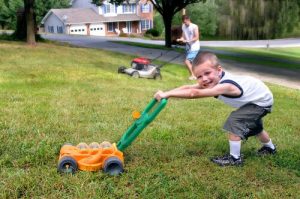How Children Learn Via Modeling

It has been said time and time again that leading by example is the best way to educate and transmit values to children. With this premise, to encourage children to learn via modeling means that you act as a “mirror” so they can observe the attitudes and behavior that they should eventually adopt.
To learn via modeling is also called vicarious learning or learning by observation. Basically, it consists of teaching through one’s own behavior. Not only is this typical of humans, but it can also be observed in many species of animals.
It proves effective because, at an early age, individuals haven’t yet developed the ideas of right and wrong. They also don’t know if a behavior is appropriate in a certain context. That’s why observing and imitating those around them gives them the best options as to how to proceed.
Adults must understand how to use modeling to teach their children appropriate behaviors. As a result, their children will begin to imitate their habits.
How children learn via modeling
- Live modeling occurs when the person who acts as a model is present in the same place as the learner.
- Symbolic modeling occurs when the model is present via audiovisual, written or oral materials, or via the imagination. For example, you can show your child the noble attitudes of his or her favorite superhero and adapt them to everyday life.
- Passive modeling consists of observing a certain behavior and executing it later. The difference is that, in these cases, the model is no longer present.
- Participant modeling is often used by sports instructors. You perform actions simultaneously with the model in order to learn them.

Stages of learning via modeling
Children follow these steps in order to absorb the behaviors, values and attitudes of a model:
- It’s necessary to choose who will transmit the lesson to the child (for example, brushing their teeth every night).
- The model must carry out the intended actions in the child’s presence.
- If necessary, you can highlight some important details and give instructions on specific steps.
- The child should be asked to pay attention and to try to retain the procedure in his or her mind.
- Next, the time comes for the child to put it into practice. It’s necessary to evaluate whether the child adopts the intended behavior little by little. Make corrections if necessary.
- In addition, it must be noted that the behavior can come on progressively. It doesn’t have to be repeated exactly the right way in the very beginning.

“We learn by example and from direct experience, because the usefulness of spoken instructions has a real limit.”
–Malcolm Gladwell–
Beware of spontaneous actions
While it’s a good idea to convey positive behaviors, we must remember that children imitate everything. And that means they also imitate our attitudes during times of conflict, tension, stress or nervousness.
As we know, these aren’t always mediated and corrected. Therefore, parents should pay attention to the following moments:
- Don’t be disrespectful in discussions or confrontations at home or in public places.
- Apologize when you hurt another person.
- Don’t insult. This is one of the easiest vices for little ones to acquire.
- Be understanding with others when they’re wrong.
- Don’t discriminate or make offensive comments towards people different from you in any way.
- Use the magic words: please, sorry and thank you.
“Your example, whether good or bad, has a powerful influence.”
–George Washington–
Undoubtedly, repetition greatly benefits the ability to learn via modeling. It’s best to imitate specific actions that are seen every day.
This process occurs even more in childhood and is enhanced when the model is someone the child admires and respects. Of course, parents, grandparents and siblings are part of this group.
Therefore, if you want your children to correct their behavior and adopt healthy habits, the best you can do is apply it yourself first.
Your example has more strength than any punishment or reward. While it takes time and patience, sooner or later it will bear fruit.
All cited sources were thoroughly reviewed by our team to ensure their quality, reliability, currency, and validity. The bibliography of this article was considered reliable and of academic or scientific accuracy.
- Manz, C. C., & Sims Jr, H. P. (1981). Vicarious learning: The influence of modeling on organizational behavior. Academy of Management Review, 6(1), 105-113. https://journals.aom.org/doi/abs/10.5465/AMR.1981.4288021
- Bandura, A. (1982). Teoría social del aprendizaje. Vergara.
- Santacoloma-Suárez, A. M. Aprendizaje del comer. INVESTIGACIONES EN COMPORTAMIENTO ALIMENTARIO, 61. https://www.researchgate.net/profile/Andres-Santacoloma-Suarez/publication/350877763_Aprendizaje_del_Comer_Una_complejidad_en_la_Infancia/links/6077eb79881fa114b402d11f/Aprendizaje-del-Comer-Una-complejidad-en-la-Infancia.pdf
This text is provided for informational purposes only and does not replace consultation with a professional. If in doubt, consult your specialist.
